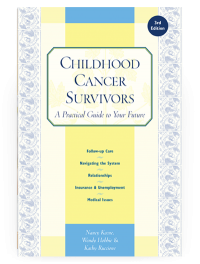Childhood Cancer Survivors
Prevention
Once you know what your risk might be, what do you do then? Practical ways to deal with this potentially upsetting information are to do everything you can to prevent a second cancer, and then take steps to make sure that if anything develops, it is detected and treated early.
I had mantle radiation for Hodgkin’s disease in the 1970s. Two small skin cancers grew under the edge of my left breast. Not any place that commonly saw the sun. But that’s where they decided to grow! I try to be cautious about sun exposure, especially with the skin over my sternum, which is very strange-looking from the radiation.
• • • • •
I had cranial radiation when I was 4 to treat high-risk leukemia. I know I have a tiny risk of a brain tumor, so when I had bad migraines at puberty, instead of just treating them with medication, I also had an MRI to check for tumors. No big deal, and no tumors. And after I went through puberty, no more migraines! I go to a really good follow-up clinic every year, and other than that, I don’t think about it.
Although you cannot alter a genetic predisposition or undo the damage from radiation or chemotherapy, you can modify your risk factors by making healthy lifestyle choices to minimize your risk. There are numerous ways to prevent cancer that are outlined in Chapter 5 . Some of these are:
-
Don’t smoke.
-
Don’t take illegal drugs or recreational inhalants.
-
Drink alcohol only in moderation.
-
Avoid exposure to the sun, wear a hat that covers the face, and use sunscreen, particularly on irradiated skin.
-
Exercise regularly.
-
Maintain a healthy body weight.
-
Eat four to six fruits and vegetables a day.
Table of Contents
All Guides- 1. Survivorship
- 2. Emotions
- 3. Relationships
- 4. Navigating the System
- 5. Staying Healthy
- 6. Diseases
- 7. Fatigue
- 8. Brain and Nerves
- 9. Hormone-Producing Glands
- 10. Eyes and Ears
- 11. Head and Neck
- 12. Heart and Blood Vessels
- 13. Lungs
- 14. Kidneys, Bladder, and Genitals
- 15. Liver, Stomach, and Intestines
- 16. Immune System
- 17. Muscles and Bones
- 18. Skin, Breasts, and Hair
- 19. Second Cancers
- 20. Homage
- Appendix A. Survivor Sketches
- Appendix B. Resources
- Appendix C. References
- Appendix D. About the Authors
- Appendix E. Childhood Cancer Guides (TM)

